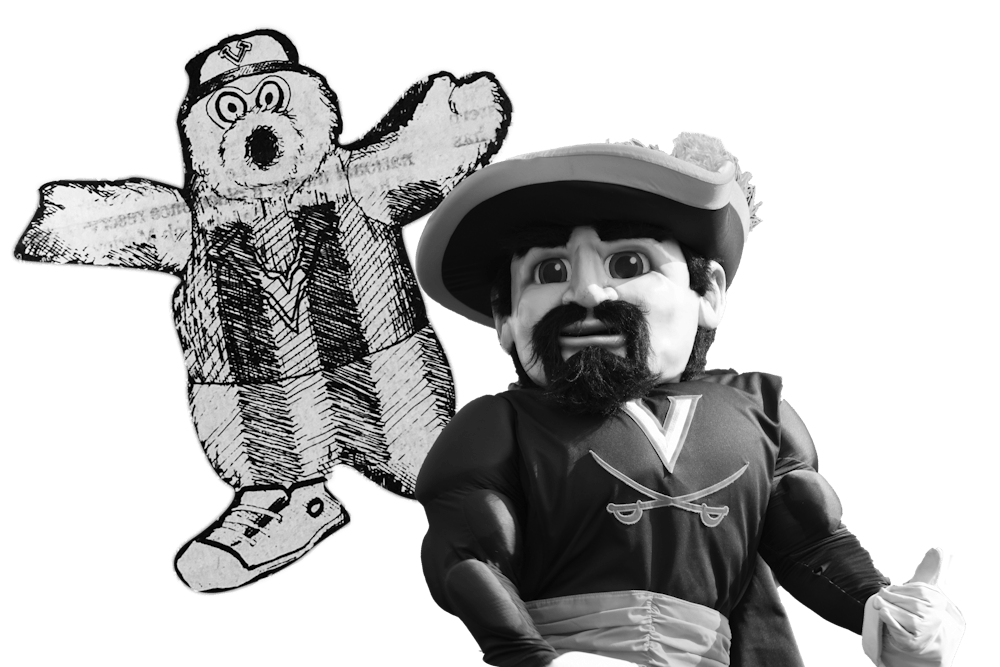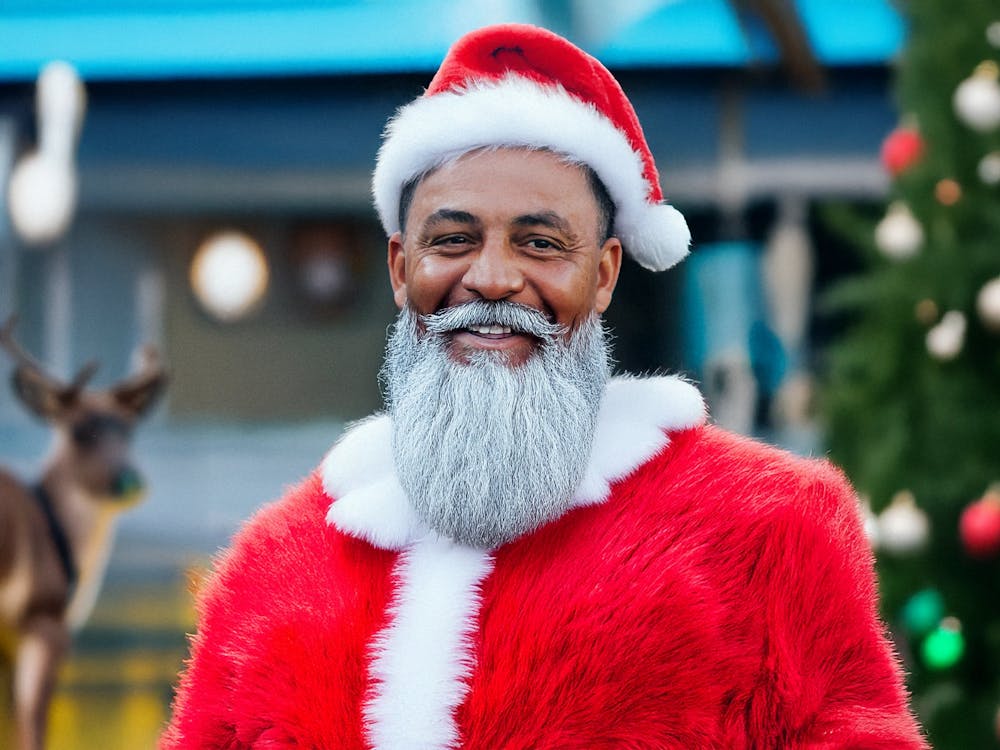Last May, The Sickos Committee, a social media group of self-styled college football fans loyal to the weirdest parts of college football, posted a thread on X containing an artifact most Virginia sports fans had no memory of. This thread followed the brief life of a mascot who lived in Charlottesville for just three weeks in 1983 — the forgotten ‘Hoo, a failed commercial stunt and object of revulsion.
Virginia has a history of iconic mascots. There was a succession of canine representatives — including Beta, who once found his way back to the Beta Theta Pi fraternity house after being left at a football game in Athens, Georgia — and Seal, who once inspired Virginia football in a comeback victory against Pennsylvania by urinating on an opposing cheerleader’s megaphone. The mounted Cavalier has also represented the team on and off since 1947, when a student on horseback rode into Scott Stadium before the Cavaliers shut out Harvard.
The introduction of AstroTurf at Scott Stadium meant the mounted Cavalier was given the boot for the time being, and a grounded Cavalier failed to excite crowds.
In that era, the Virginia football team was in a sorry state. Between joining the Atlantic Coast Conference in 1954 and 1983, the team won more games than it lost exactly once. In the two years prior to the introduction of the ‘Hoo, the team had won three games, two of them against non-major school Virginia Military Institute.
Even in the 1970s, athletic departments depended on football revenue to provide money for other sports. The Cavaliers’ continued winless ways were not effectively pulling in fans, and money was getting tight within the athletic department. The pressure was on to find something to draw the fans to Scott Stadium even if the football on display was unwatchable.
Enter Todd Turner. A former ticket director for the athletic department, he had risen up to Director of Promotions and Associate Athletic Director below Athletic Director Richard Schultz in just a few short years. With university officials in strong opposition to in-stadium advertising, Turner needed to find a way to make money fast.
Turner found inspiration further north, where the Philadelphia Phillies had stumbled into a new way to generate cash with the 1977 introduction of their mascot, the Philly Phanatic. The Phanatic was not the first mascot in history, but he proved that fans would show up to games and buy merchandise — even if the team was historically bad.
The Phanatic sparked a wave of fuzzy mascots across the country, drawing media attention and sellout crowds, even to historically bad franchises. Turner saw an opportunity and seized it —he created a mascot that was eerily similar to the Phanatic but decked out in Virginia colors. Named after the school’s unofficial Wahoo mascot, the ‘Hoo boasted orange fuzz, owned a Phanatic-like bulbous snout and a wagging tongue. It sported an oversized blue vest and a blue and white ballcap, both emblazoned with an orange “V” and paired with blue and white sneakers.
The ‘Hoo was immediately reviled. According to Sports Illustrated, the ‘Hoo was pelted with bottles and ice cubes from the stands and had its tongue removed by fraternity boys during the first game, a 38-30 victory over Duke. After the game, multiple students expressed their distaste for the mascot to The Cavalier Daily.
“The spirit of the Cavalier was executed most heinously Saturday when he was replaced by ‘the ‘Hoo’,” two students wrote in an op-ed the following week. “A bastard child born of an incestuous relationship between the athletic department and a cash register. We do not want to be represented by a beast resembling a cross between Papa Smurf and Yogi Bear.”
Editorial cartoons that week showed the ‘Hoo being run over by an M1 tank, pushed back into a car, shown the nearest exit and more.
Professor Carl Knospe of the Mechanical and Aerospace Engineering department, then a student at the University, remembered the reaction to the new mascot.
“It came out at one football game that season and was booed off the field almost immediately — the reaction from the crowd was very negative,” Knospe said.
Forced to take into account the safety of the student inside the ‘Hoo costume, the mascot only made a brief appearance the next Saturday against Navy — also a victory.
However, the athletic department again created controversy. Instead of the traditional halftime pep band performance, the Naval Drum and Bugle Corps was invited to play halftime in another bid to boost attendance. However, this backfired, sparking rage in the pep band and general student body, with Turner again taking most of the heat.
After those two weeks, Schultz invited the student council to propose an alternate mascot to replace the ‘Hoo, reacting to backlash by claiming he also did not like the creature.
“The ‘Hoo can die a sudden death for all I care,” Schultz said.
It was decided that the ‘Hoo would engage in a climactic battle with the pep band mascot, “the What”, a fuzzy, blue parody of the ‘Hoo.
The following week against JMU, the ‘Hoo “shot” the What during the pep band’s show and then was supposed to disappear forever. However, after the mock shooting, the student inside the costume saw some of the kids in the crowd were upset by the performance. Like the prodigal son, the ‘Hoo returned to the field one last time to offer them comfort — and then it was gone.
In the weeks after the disappearance of the ‘Hoo, several more op-eds ran in The Cavalier Daily, lambasting Turner and the athletic department for their perceived greed and further degrading the ‘Hoo. One particular opinion piece advocated for tying the mascot costume to the back of the escort service car and dragging it around Grounds on game days, creating ‘Hoo pinatas and satirizing Student Council by nominating the ‘Hoo for student council president.
As the year progressed, the ‘Hoo retreated from memory. It was very rarely mentioned again by The Cavalier Daily after November 1983. The only traces of it left on the internet before the Sickos Committee tweeted the Sports Illustrated article from late 1983 were a mention on the official Virginia Sports Traditions page and a few blog posts. It was like the ‘Hoo had never existed.
Meanwhile, Virginia has kept the mascot wheel churning. The AstroTurf was removed from Scott Stadium and a human Cavalier, most recently Julie Caruccio, has ridden in on horseback to the strains of AC/DC’s “Thunderstruck” ever since. A costumed Cavalier has been present at athletic events since 1984, a direct replacement for the ‘Hoo. Another costumed mascot named ‘Lil Hoo, again developed after tightening athletic budgets, also saw the field for just a few years in the early 2000’s. The athletics department has not introduced a Wahoo themed mascot since.
The original purpose of mascots was to attract luck, not cash. Despite the commercial motivations behind the ‘Hoo and the near universal disdain it acquired, Virginia went 3-0 in games the ‘Hoo was on the field in 1983 and 3-5 otherwise. As the program has succumbed to losing ways and the ‘Hoo’s fortieth birthday passes us by, one wonders – if it meant winning a few more games, who would say no to bringing back the ‘Hoo?







